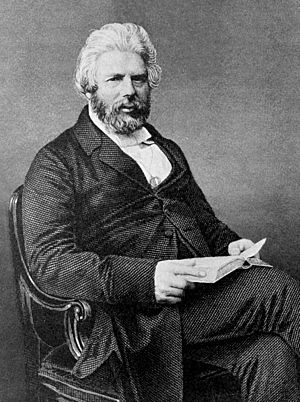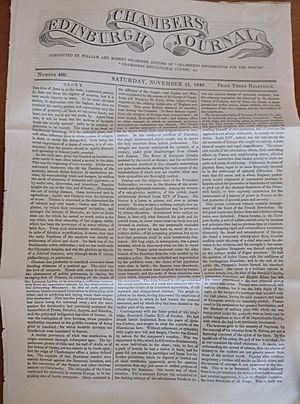Robert Chambers (publisher, born 1802) facts for kids
Quick facts for kids
Robert Chambers
|
|
|---|---|

Chambers c. 1863
|
|
| Born | 10 July 1802 Peebles, Peeblesshire, Scotland |
| Died | 17 March 1871 (aged 68) St Andrews, Fife, Scotland |
| Resting place | St Regulus Chapel, St Andrews |
| Occupation | Co-founder and partner, W. & R. Chambers Publishers, Edinburgh |
| Education | The High School, Edinburgh |
| Notable works |
|
| Spouse |
|
| Children | son: Robert Chambers Jr. (1832–1888) |
| Relatives |
|
Robert Chambers (born July 10, 1802 – died March 17, 1871) was an important Scottish publisher, scientist, and writer. He was a geologist, someone who studies rocks and the Earth. He also thought a lot about how life on Earth changes over time.
Robert worked with his older brother, William Chambers. Together, they had a big influence on science and politics in the mid-1800s. Robert also secretly wrote a very famous and debated book called Vestiges of the Natural History of Creation. People did not know he wrote it until after he died.
Contents
Robert Chambers' Early Life
Robert Chambers was born in Peebles, Scotland, on July 10, 1802. His parents were Jean Gibson and James Chambers. James was a cotton manufacturer, meaning he made cotton products. Robert was the second of six children in his family.
Peebles was a small town with old and new parts. Most people there were weavers or laborers. Robert's family lived in a house his grandfather built. The ground floor was used as their workshop.
How Robert Loved Books
Robert loved books from a young age. A small library in town, run by Alexander Elder, helped him discover many stories. His father sometimes bought books for their home. One day, Robert found a full set of the Encyclopædia Britannica in their attic. He spent many years eagerly reading it.
Later in life, Robert remembered how thankful he felt for this collection of knowledge. His brother William said that for Robert, learning new things was "the highest of earthly enjoyments."
Robert's School Days
Robert went to local schools. He was very good at reading and writing, even though he found school boring. He learned reading, writing, and arithmetic. In grammar school, he studied Latin and Ancient Greek. Teachers often used physical punishment for misbehaving students. Even though school was not exciting, Robert learned a lot from books outside of class.
A Family Challenge and Moving to Edinburgh
Both Robert and William were born with extra fingers and toes. Doctors tried to fix this. William's operation worked, but Robert was left with a slight limp. Because of this, Robert often stayed indoors and read his books while other boys played outside.
Robert studied longer than his brother William. He was planning to become a minister, but he changed his mind at age fifteen. Around this time, his father's cotton business faced problems because of new machines called power looms. His father had to close the business and became a draper, selling cloth.
His father also lent money to some French prisoners of war. When they left suddenly, he lost the money and had to declare bankruptcy. In 1813, the family moved to Edinburgh. Robert continued his education at the High School. William became a bookseller's helper.
Starting His Own Book Business
In 1818, at sixteen, Robert started his own book business. He set up a bookstall on Leith Walk. At first, he only had a few old books from his father. They were worth only a few pounds. But by the end of the first year, his stock was worth more, and he slowly became successful.
Robert's Early Writings
While Robert built his book business, his brother William started printing his own pamphlets. Soon, Robert and William decided to work together. Robert would write, and William would print.
Their first project was a magazine called The Kaleidoscope, or Edinburgh Literary Amusement. It came out every two weeks in 1821 and 1822. After that, they published Illustrations of the Author of Waverley (1822). This book described people who might have inspired characters in Walter Scott's novels.
Robert then wrote Traditions of Edinburgh (1824), showing his love for Edinburgh's history. He followed this with other books about Scotland, like Walks in Edinburgh (1825) and Picture of Scotland (1826). These books made him friends with Walter Scott himself. After Scott died, Robert wrote a book about his life in 1832.
Robert's Marriage and Family
On December 7, 1829, Robert Chambers married Anne Kirkwood. They had 14 children together, but three died when they were babies. Their other children included Robert Jr., Nina, Mary, Anne, Janet, Eliza, Amelia, James, William, Phoebe, and Alice.
W. & R. Chambers Publishing Company
In 1832, Robert's brother William started a weekly magazine called Chambers's Edinburgh Journal. It quickly became very popular. Robert first wrote articles for it. Later, he became a joint editor with William. His work greatly helped the magazine's success.
The two brothers eventually became partners. They formed the book publishing company called W. & R. Chambers Publishers.
Robert also ran a bookshop and library with his younger brother, James. William had his own shop too. Robert lived near his shop at the time.
Robert wrote or helped write many other important books. These included the Biographical Dictionary of Eminent Scotsmen (1832–1835) and the Cyclopædia of English Literature (1844). He also wrote about the poet Robert Burns (1851) and Scottish history in Domestic Annals of Scotland (1859–1861). His last big work was The Book of Days (1862–1864).
The brothers also oversaw the creation of Chambers's Encyclopaedia (1859–1868). This huge encyclopedia was edited by Dr. Andrew Findlater.
Vestiges of Creation: A Secret Book
Robert Chambers became very interested in geology, the study of Earth's history through rocks. In 1844, he became a member of the Geological Society of London. He also joined the Royal Society of Edinburgh in 1840. This connected him with many scientists.
In 1848, Robert published his first geology book, Ancient Sea Margins. He later traveled to places like Scandinavia and Canada to explore geology. He wrote about these trips in Tracings of the North of Europe (1851) and Tracings in Iceland and the Faroe Islands (1856).
The Controversial Book
His most famous book, however, was one he never put his name on. In 1844, Robert finished writing Vestiges of the Natural History of Creation. He dictated it to his wife, Anne Kirkwood, while recovering from an illness.
This book became a huge international bestseller. It talked about how the universe and life developed over long periods. It suggested that species changed over time, similar to ideas from Jean-Baptiste Lamarck. These ideas were very new and often not accepted by scientists at the time.
Robert kept his authorship a secret because he knew the book would cause a big stir. He did not want to harm his and his brother's publishing business. Only four people knew his secret: his wife, his brother William, a friend named Alexander Ireland, and Robert Cox. All letters about the book went through Ireland, and his wife copied all manuscripts to hide Robert's handwriting.
The book suggested that God might not directly control every part of nature and society. This worried many people, especially religious leaders. They feared it could lead to social unrest. For example, a geologist named Adam Sedgwick said the book's ideas would bring "ruin and confusion."
Despite the criticism, the book was very popular and had many new editions. It brought the idea of evolution into common discussions, even before Charles Darwin's famous book Origin of Species came out in 1859.
Other Activities and Later Life
In 1847, Robert Chambers gave a talk about ancient beaches. Some scientists at the meeting, like Adam Sedgwick and Charles Lyell, strongly disagreed with his ideas. They felt his conclusions were too extreme. A bishop even gave a sermon criticizing his way of doing science.
In 1848, Robert considered running for a political position in Edinburgh. However, rumors spread that he was the secret author of Vestiges. His opponents used this to try and discredit him. Robert decided to withdraw from the election.
In 1851, Robert joined other writers to help restart the Westminster Review. This magazine promoted new ideas, including the concept of evolution.
Robert Chambers also enjoyed golf. His son, Robert Jr., followed him into publishing and became a famous golfer.
The Book of Days and Death

The Book of Days was Robert Chambers' last major work. It was a collection of interesting facts and traditions related to each day of the year. People believe that working so hard on this book may have made him sick.
Two years before he died, the University of St Andrews gave him an honorary degree. He also became a member of the Athenaeum Club in London.
Robert Chambers died on March 17, 1871, in St Andrews. He was buried in the churchyard of St Andrews Cathedral. His brother William later put up a memorial window for Robert in St Giles Cathedral in Edinburgh.
A year after Robert's death, William published a book about his brother's life. However, William still did not reveal that Robert wrote Vestiges. It wasn't until 1884 that Alexander Ireland finally announced Robert Chambers as the author of Vestiges in a new edition of the book.
Robert Chambers' Writings
Main Books and Publications
- The Kaleidoscope, or Edinburgh Literary Amusement. 1821–1822.
- Illustrations of the Author of Waverley. 1822.
- Walks in Edinburgh. 1825.
- Popular Rhymes of Scotland. 1826.
- Picture of Scotland. 1827.
- History of the Rebellion of 1745. 1828.
- Life of Sir Walter Scott. 1832.
- Gazetteer of Scotland (with William Chambers). 1832.
- Biographical Dictionary of Eminent Scotsmen. 1833–1835.
- Cyclopaedia of English Literature (with Robert Carruthers). 1840.
- Vestiges of the Natural History of Creation (published anonymously). 1844.
- Ancient Sea Margins. 1848.
- Tracings of the North of Europe. 1851.
- Domestic Annals of Scotland. 1859–1861.
- The Book of Days. 1864.
- Traditions of Edinburgh. 1868.
Edited Works
- Chambers's Edinburgh Journal. Started 1832.
- Chambers's Information for the People. 1833–1835.
- Chambers's Educational Course. Started 1835.
See also
 In Spanish: Robert Chambers para niños
In Spanish: Robert Chambers para niños


